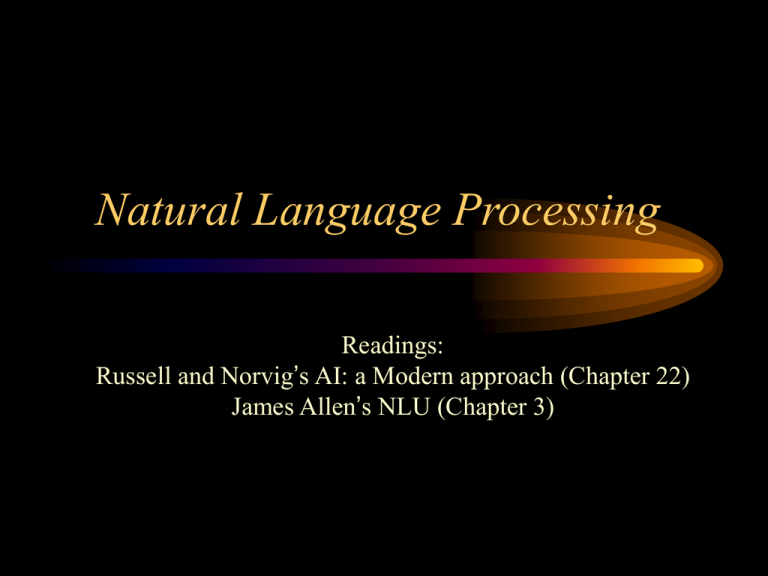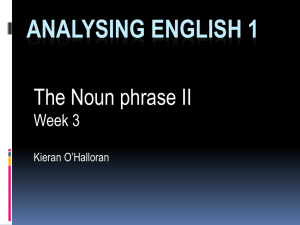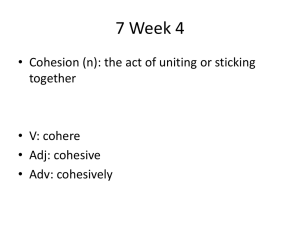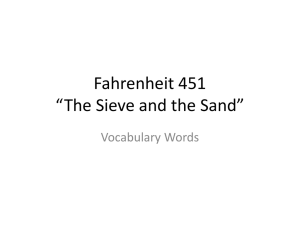Natural Language Processing
advertisement

Natural Language Processing Readings: Russell and Norvig’s AI: a Modern approach (Chapter 22) James Allen’s NLU (Chapter 3) What is Natural Language Processing? NLP: applications • Speech recognition and synthesis • Machine translation • Document processing – information extraction – summarization • Text generation • Dialog systems (typed and spoken) Levels of language analysis • Phonology: What words (or sub words) are we dealing with? • Morphology: How words are constructed from more basic meaning units? • Syntax: What phrases are we dealing with? • Semantics: What’s the context-free meaning? • Pragmatics: What is the more exact (context-dependent) meaning? • Discourse Knowledge: how the immediately preceding sentences affect the interpretation of the next sentence? • World knowledge: Using general knowledge about the world Levels of language analysis • Phonetics: sounds -> words – /b/ + /o/ + /t/ = boat • Morphology: morphemes -> words – friend + ly = friendly • Syntax: word sequence -> sentence structure • Semantics: sentence structure + word meaning -> sentence meaning • Pragmatics: sentence meaning + context -> more precise meaning • Discourse and world knowledge Levels of language analysis (cont.) 1. Language is one of fundamental aspects of human behavior and is crucial component of our lives. 2. Green frogs have large noses. 3. Green ideas have large noses. 4. Large have green ideas nose. 5. I go store. Why is NLP Hard? “At last, a computer that understands you like your mother” Ambiguity • “At last, a computer that understands you like your mother” 1. (*) It understands you as well as your mother understands you 2. It understands (that) you like your mother 3. It understands you as well as it understands your mother • 1 and 3: Does this mean well, or poorly? Ambiguity at Many Levels At the acoustic level (speech recognition): 1. “ ... a computer that understands you like your mother” 2. “ ... a computer that understands you lie cured mother” Ambiguity at Many Levels At the syntactic level: Different structures lead to different interpretations. More Syntactic Ambiguity Ambiguity at Many Levels At the semantic (meaning) level: Two definitions of “mother” • a woman who has given birth to a child • a substance consisting of bacteria, used to produce vinegar (i.e., mother of vinegar) This is an instance of word sense ambiguity Ambiguity at Many Levels At the discourse level: • Alice says they’ve built a computer that understands you like your mother • But she ... • ... doesn’t know any details • ... doesn’t understand me at all Syntactic analysis • Syntax can make explicit when there are several possible interpretations – (Rice flies) like sand. – Rice (flies like sand). • Knowledge of ‘correct’ grammar can help finding the right interpretation – Flying planes are dangerous. – Flying planes is dangerous. Syntax shows how words are related in a sentence. Visiting aunts ARE boring. vs Visiting aunts IS boring. Subject verb agreement allows us to disambiguate here. How do we represent syntax? Parse Tree An example: – Parsing sentence: – "They are cooking apples." Parse 1 Parse 2 How do we represent syntax? List Sue hit John [ s, [np, [proper_noun, Sue] ] , [vp, [v, hit], [np, [proper_noun, John] ] What strategies exist for trying to find the structure in natural language? Top Down vs. Bottom Up Bottom - Up John, hit, the, cat prpn, hit, the, cat prpn, v, the, cat prpn, v, det, cat prpn, v, det, n np, v, det, n np, v, np np, vp s Top - Down s s -> np, vp s -> prpn, vp s -> John, v, np s -> John, hit, np s -> John, hit, det,n s -> John, hit, the,n s -> John, hit, the,cat What strategies exist for trying to find the structure in natural language? Top Down vs. Bottom Up Bottom - Up John, hit, the, cat prpn, hit, the, cat prpn, v, the, cat prpn, v, det, cat prpn, v, det, n np, v, det, n np, v, np np, vp s Top - Down s s -> np, vp s -> prpn, vp s -> John, v, np s -> John, hit, np s -> John, hit, det,n s -> John, hit, the,n s -> John, hit, the,cat Better if many alternative rules for a phrase Worse if many alternative terminal symbols for each word Better if many alternative terminal symbols for each word Worse if many alternative rules for a phrase What does an example grammar for English look like? • Re-write rules 1.sentence -> noun phrase , verb phrase 2.noun phrase -> art , noun 3.noun phrase -> art , adj , noun 4.verb phrase -> verb 5.verb phrase -> verb , noun phrase Top down parsing (as a search procedure) 1 The 2 dog 3 cried 4 Step Current state Backup States 1 2 3 ((S) 1) ((NP VP) 1) ((ART N VP) 1) 4 ((N VP) 2) initial position Rule 1 Rules 2 & 3 ((ART ADJ N VP) 1) Match Art with the ((ART ADJ N VP) 1) Match N with dog ((ART ADJ N VP) 1) Rules 4 & 5 ((V NP) 3) ((ART ADJ N VP) 1) Success 5 ((VP) 3) 6 7 ((V) 3) comment Chart Parsing General Principles: A Bottom-Up parsing method – Construct a parse starting from the input symbols – Build constituents from sub-constituents – When all constituents on the RHS of a rule are matched, create a constituent for the LHS of the rule The Chart allows storing partial analyses, so that they can be shared. Data structures used by the algorithm: – The Key: the current constituent we are attempting to “match” – An Active Arc: a grammar rule that has a partially matched RHS – The Agenda: Keeps track of newly found unprocessed constituents – The Chart: Records processed constituents (non-terminals) that span substrings of the input 25 Chart Parsing Steps in the Process: Input is processed left-to-right, one word at a time 1. Find all POS of the current word (terminal-level) 2. Initialize Agenda with all POS of the word 3. Pick a Key from the Agenda 4. Add all grammar rules that start with the Key as active arcs 5. Extend any existing active arcs with the Key 6. Add LHS constituents of newly completed rules to the Agenda 7. Add the Key to the Chart 8. If Agenda not empty – go to (3), else go to (1) 26 The Chart Parsing Algorithm Extending Active Arcs with a Key: Each Active Arc has the form: <pi> [A X1…C…Xm] <pj> - A Key constituent has the form: <pj >C<pk> - When processing the Key <p1>C<p2>, we search the active arc list for an arc <p0>[A X1…C…Xm]<p1>, and then create a new active arc <p0>[A X1…C… Xm]<p2> - If the new active arc is a completed rule: <p0>[A X1…C]<p2>, then we add <p0>A<p2> to the Agenda - After “using” the key to extend all relevant arcs, it is entered into the Chart 27 The Chart Parsing Algorithm The Main Algorithm: parsing input x = x1…xn 1. i = 0 2. If Agenda is empty and i < n then set i = i + 1, find all POS of xi and add them as constituents <pi>C<pi+1> to the Agenda 3. Pick a Key constituent <pj>C< pk > from the Agenda 4. For each grammar rule of form A CX1…Xm, add <pj>[A CX1…Xm]<pj> to the list of active arcs 5. Use Key to extend all relevant active arcs 6. Add LHS of any completed active arcs into the Agenda 7. Insert the Key into the Chart 8. If Key is <1>S<n> then Accept the input Else goto (2) 28 Chart Parsing - Example The Grammar: (1) S NP VP (2) NP ART ADJ N (3) NP ART N (4) NP ADJ N (5) VP AUX VP (6) VP V NP 29 Chart Parsing - Example The input: “x = The large can can hold the water” POS of Input Words: – – – – – the: ART large: ADJ can: N, AUX, V hold: N, V water: N, V 30 The large can can hold the water 31 The large can can hold the water 32 The large can can hold the water 33 The large can can hold the water 34 The final Chart 35








